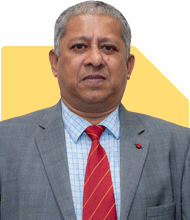33-year-old mom with 8 lakhs liability seeks investment and savings advice
Ramalingam Kalirajan |8317 Answers |Ask -Follow
Mutual Funds, Financial Planning Expert - Answered on Jul 30, 2024
He has an MBA in finance from the University of Madras and is a certified financial planner.
He is the director and chief financial planner at Holistic Investment, a Chennai-based firm that offers financial planning and wealth management advice.... more

Hy I am 33 years old and have two year old baby girl.I am working and have annual income of 7.5 lakhs.I only have one lic yearly payment 45000.i have 8 lakhs liability.Kinldy advise me to start investment plans and savings.
You have a steady income of Rs 7.5 lakhs per year. You also have a two-year-old daughter and an existing LIC policy. Let's work towards a comprehensive investment and savings plan.
Prioritising Debt Repayment
High Priority: Clear your Rs 8 lakh liability first. Reducing debt lowers financial stress.
Systematic Approach: Allocate a portion of your monthly income towards this repayment.
Building an Emergency Fund
Essential Safety Net: Aim to save at least six months' worth of expenses. This fund ensures financial stability during unforeseen circumstances.
Liquid Funds: Park this money in a liquid fund. They offer quick access and reasonable returns.
Health and Life Insurance
Adequate Cover: Ensure you have sufficient health insurance. This prevents erosion of savings due to medical emergencies.
Term Insurance: Consider a term plan. It offers high coverage at a low cost, ensuring financial security for your family.
Starting Systematic Investment Plans (SIPs)
Regular Investment: Begin with SIPs in mutual funds. They ensure disciplined investing and benefit from rupee cost averaging.
Diversified Portfolio: Choose a mix of equity and debt funds. This balances growth potential and risk.
Equity Funds for Long-term Growth
Higher Returns: Equity funds have the potential for higher returns over the long term. They are suitable for your long-term goals, like your daughter's education and marriage.
Active Management: Actively managed funds often outperform passive ones. They adapt to market conditions for better returns.
Debt Funds for Stability
Low Risk: Debt funds provide stability and lower risk. They are suitable for medium-term goals and balancing your portfolio.
Regular Income: These funds can also offer a regular income stream, useful post-retirement.
Avoiding Index and Direct Funds
Index Funds: These funds only mimic the market and often yield lower returns. They lack active management to navigate market fluctuations.
Direct Funds: Managing direct funds requires significant time and expertise. Investing through a Certified Financial Planner ensures better guidance and management.
Education and Marriage Fund for Your Daughter
Separate Fund: Create a separate investment for your daughter's future needs. Start early to benefit from compounding.
Long-term Growth: Invest in equity mutual funds. They offer better growth for long-term goals.
Tax-saving Investments
ELSS Funds: Equity Linked Savings Schemes offer tax benefits under Section 80C. They also provide the potential for higher returns.
PPF and NPS: Consider Public Provident Fund (PPF) and National Pension System (NPS) for tax-saving and long-term growth.
Reviewing and Adjusting Your Investments
Regular Review: Periodically review your investment portfolio. Ensure it aligns with your goals and risk tolerance.
Professional Guidance: Seek advice from a Certified Financial Planner. They can provide tailored strategies and adjustments.
Final Insights
Clearing debt, building an emergency fund, and investing in SIPs are crucial. Diversify between equity and debt funds for balanced growth and stability.
Best Regards,
K. Ramalingam, MBA, CFP
Chief Financial Planner
www.holisticinvestment.in
You may like to see similar questions and answers below
Ramalingam Kalirajan |8317 Answers |Ask -Follow
Mutual Funds, Financial Planning Expert - Answered on Jun 18, 2024
Ramalingam Kalirajan |8317 Answers |Ask -Follow
Mutual Funds, Financial Planning Expert - Answered on Jul 02, 2024
Ramalingam Kalirajan |8317 Answers |Ask -Follow
Mutual Funds, Financial Planning Expert - Answered on Jul 03, 2024
Ramalingam Kalirajan |8317 Answers |Ask -Follow
Mutual Funds, Financial Planning Expert - Answered on Sep 28, 2024
Dr Dipankar Dutta |1195 Answers |Ask -Follow
Tech Careers and Skill Development Expert - Answered on May 03, 2025
Dr Dipankar Dutta |1195 Answers |Ask -Follow
Tech Careers and Skill Development Expert - Answered on May 03, 2025
Radheshyam Zanwar |1591 Answers |Ask -Follow
MHT-CET, IIT-JEE, NEET-UG Expert - Answered on May 03, 2025
Dr Nagarajan Jsk |361 Answers |Ask -Follow
NEET, Medical, Pharmacy Careers - Answered on May 03, 2025
T S Khurana |461 Answers |Ask -Follow
Tax Expert - Answered on May 03, 2025
Kanchan Rai |583 Answers |Ask -Follow
Relationships Expert, Mind Coach - Answered on May 03, 2025
Kanchan Rai |583 Answers |Ask -Follow
Relationships Expert, Mind Coach - Answered on May 03, 2025
Prof Suvasish Mukhopadhyay |607 Answers |Ask -Follow
Career Counsellor - Answered on May 03, 2025
Prof Suvasish Mukhopadhyay |607 Answers |Ask -Follow
Career Counsellor - Answered on May 03, 2025
Milind Vadjikar |1205 Answers |Ask -Follow
Insurance, Stocks, MF, PF Expert - Answered on May 03, 2025



























